Physical Address
304 North Cardinal St.
Dorchester Center, MA 02124
Multifetal pregnancies have higher rates of perinatal morbidity and mortality than singletons.
Chorionicity is the major determining feature for the inherent unique complications faced by multiple gestations.
Fetal growth differences and congenital malformations are increased in all types of multiple gestations.
In monochorionic twins with a single demise, there is a high risk of severe cerebral and other injuries in the survivor.
Sonography permits the diagnosis of syndromes unique to monochorionic twins, including twin-twin transfusion syndrome, twin anemia polycythemia sequence, twin reversed arterial perfusion sequence, and conjoined twins.
Pregnancies with more than one fetus have become an increasingly common obstetric occurrence, primarily as a result of assisted reproductive technologies. Most multifetal pregnancies are twins, with higher-order multiples also possible. The rate of twins occurring naturally is 1 in 80 births, yet the rate of twin births continues to rise. According to the Center for Disease Control Vital Statistics, whereas the number of overall births in the United States was stable to slightly decreased in 2013 compared with 2012, the rate of twins reached a new high of 33.7 per 1000 births. The rate of triplet or higher births has been dropping since 1998, with a 2013 rate of 119.5 per 100,000 births. Modifications of assisted reproductive techniques are in part responsible for the declining rate of triplet and higher-order multiple gestations since the peak in 1998. Multifetal pregnancies are subject to all the same considerations of singleton pregnancies but are also at particular risk for premature delivery and growth restriction. In 2013, more than one of every two twins and more than 9 of every 10 triplets was born preterm or with low birth weight. In addition, there are unique issues that arise in multiple gestations, and it is critical for imagers to have a full understanding of these possible complications.
Twins are either dizygotic (fraternal) or monozygotic (identical). Among spontaneous twins, approximately two-thirds are dizygotic and one-third are monozygotic. Dizygotic twins occur when two separate ova are fertilized by two separate sperm. The rate of dizygotic twinning varies with maternal age (increased with older mothers), race, and family history. Monozygotic twins occur when a single ovum is fertilized by a single sperm and the embryo then divides from 2 to 14 days after fertilization. The timing of the division will dictate the type of twin. Spontaneous monozygotic twinning is uniform across the world (3.5/1000), and historically is not affected by maternal age, race, or other known factor. However, there is currently an increased incidence of monozygotic twins from 2 to 12 times the expected rate following in vitro fertilization. It has been reported that in patients undergoing assisted reproduction, the timing of single embryo transfer can affect the rate of monozygotic twins, with a higher rate seen following a 5- to 6-day transfer as compared to a 2- to 3-day transfer and a higher rate in patients who have undergone assisted hatching. Higher-order multiples may have any combination of zygosity.
For management of a twin pregnancy, the type of twin is characterized by chorionicity rather than zygosity. Chorionicity is the major determining feature for the inherent unique complications faced by multiple gestations, with monochorionic pregnancies at the highest risk. Therefore accurate determination of chorionicity is critical to ensure appropriate obstetric management of a twin pregnancy.
Dizygotic twins are always dichorionic diamniotic, meaning that each twin has its own placenta (chorion), amnion, and amniotic fluid. Each twin exists in a separate intrauterine environment, and the twins are genetically different. In contrast, there are three possible variations of chorionicity for monozygotic twins, who are genetically identical. Twins that occur when a single zygote divides within the first 4 days after fertilization have their own placenta (chorion), amnion, and amniotic fluid (dichorionic diamniotic, seen in one-third of cases). Monozygotic twins that occur from a later division share a placenta (chorion), but each has its own amnion ( monochorionic diamniotic, seen in two-thirds). When the division occurs between days 7 and 14, the twins will share a placenta (chorion), amnion, and amniotic fluid ( monochorionic, monoamniotic, seen in approximately 1%) ( Fig. 32.1 ). Any later time of division will result in conjoined twins. The increased risks associated with multiple gestations are related to chorionicity rather than zygosity, and ultrasound plays a critical role in the determination of twin type. Chorionicity is most easily and accurately determined via sonography in the first trimester. Both chorionicity and amnionicity must be established for each embryo.

Ultrasonography plays a vital role in the evaluation of multiple gestations, beginning with the first-trimester study. It is at this examination that the possibility of a twin or higher-order gestation will first be raised. A transvaginal approach is standard for early pregnancy (<8 weeks' gestational age) and may be useful later in the first trimester if transabdominal imaging is not definitive. Determination of chorionicity is best performed very early in gestation, when the gestation sac size is small and the number of distinct sacs can be clearly established. The number of sacs will determine the number of chorions ( Fig. 32.2 , Video 32.1). Each sac should be evaluated for the presence of a yolk sac, embryo, and cardiac activity. To successfully identify monochorionic twins or higher-order multiples, careful evaluation of the contents of each sac is critical, to search for more than one yolk sac or embryo. In addition to accurately determining chorionicity, first-trimester ultrasound is also highly accurate at dating pregnancy, which is particularly important for multiple gestations. The initial ultrasound report must clearly define the type of gestation, including chorionicity for each embryo, and should provide a single gestational age, as the first sonogram will be used for dating and for directing management of the pregnancy. In patients who have conceived via in vitro fertilization, the embryo transfer date should be used to establish the gestational age. For spontaneous multiples, if the size of the embryos is similar, an average of crown-rump lengths will provide an accurate gestational age. If the embryos are significantly different in size, the pregnancy should be dated based on the crown-rump length of the largest embryo, as any size discrepancy in the first trimester is likely related to an abnormality of the smaller embryo.
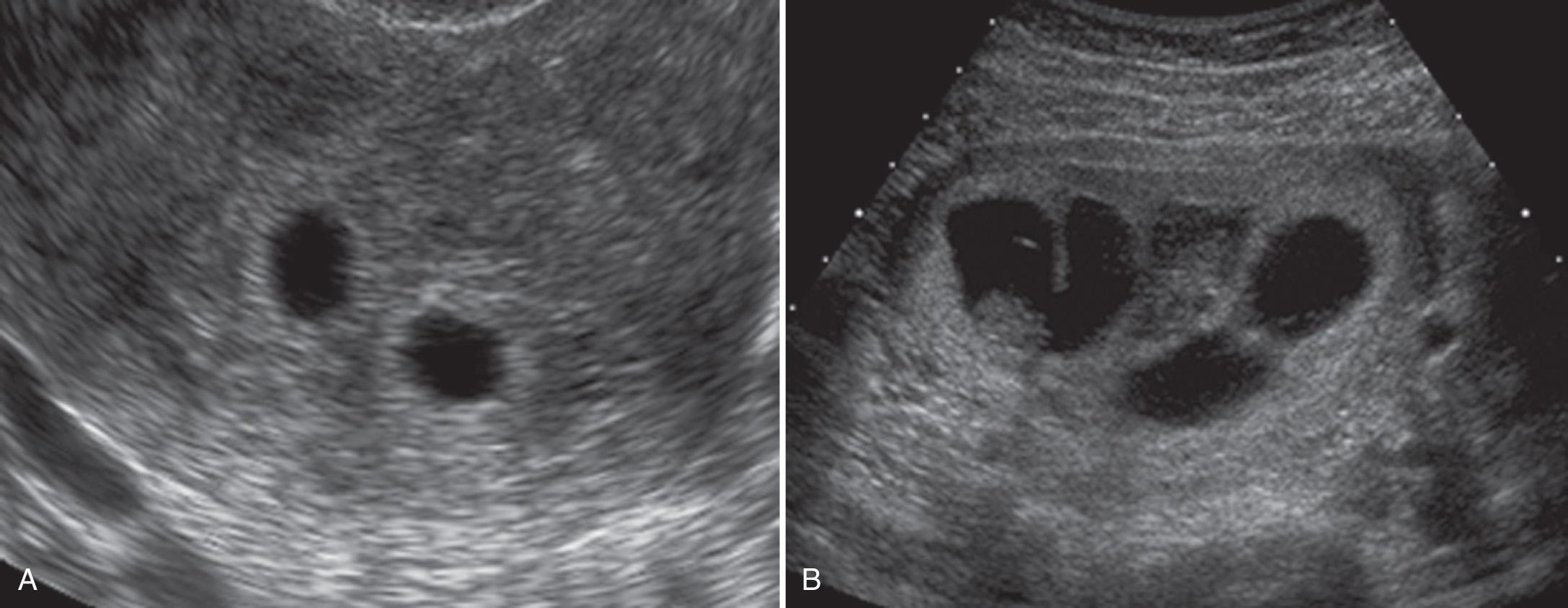
A potential pitfall in the early assessment of multiple gestations is the “appearing twin.” At very early gestational ages (<7 weeks), the number of gestational sacs in the uterus may be undercounted, and the content of each sac is indeterminate. A second or third gestational sac may appear, or a second embryo may be seen within a single sac. In contrast, because of the high background loss rate in the first trimester, twins may also “vanish.” Loss of a twin before 8 weeks' gestational age has minimal, if any, effect on the surviving twin, regardless of the chorionicity.
Two distinct gestational sacs within the endometrial cavity indicates dichorionic twins. A single gestational sac containing two yolk sacs is a monochorionic pregnancy, and amnionicity then needs to be determined. The number of yolk sacs within a sac was historically thought to accurately predict the number of amnions ; that is, two yolk sacs in a single gestational sac corresponds with monochorionic diamniotic twins while one yolk sac with two embryos indicates monochorionic monoamniotic twins. However, more recently there have been reports of two yolk sacs leading to two embryos within a single amnion, as well as a single yolk sac leading to two embryos and two separate amniotic sacs. It is clear that early multiples require close follow-up before assigning the amnionicity. The amnion can first be appreciated around the embryo just after 7 weeks' gestation; however, it may be very subtle, and scanning at 8 or 9 weeks' gestation or later may be more straightforward. Ultrasound has been shown to be highly accurate in assigning chorionicity during the first trimester, in particular with the high resolution provided with a transvaginal transducer ( Fig. 32.3 , Video 32.2). In one large multicenter study, assignment of chorionicity with ultrasound was correct in 93.6% of twin gestations when performed before 20 weeks, with the most accurate classification occurring in pregnancies less than 14 weeks. In this cohort, the likelihood of misclassification rose with each week of gestational age.
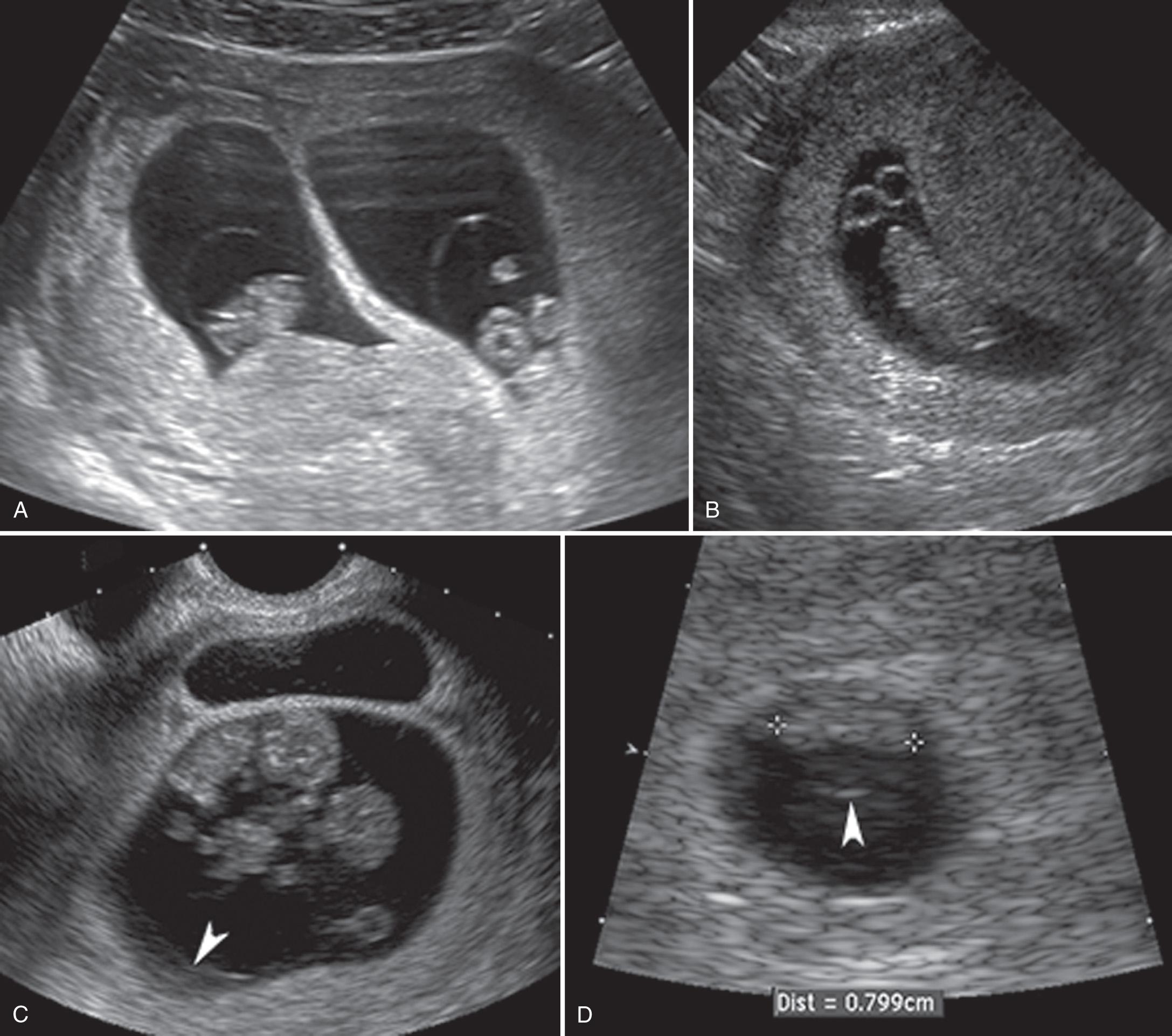
As the gestational sacs begin to grow and fill the endometrial cavity, the sacs begin to impress on each other, and it may be less obvious whether there are two separate sacs. At this time in the late first trimester and beyond, other methods can be used to determine chorionicity with sonography ( Table 32.1 ).
| Dichorionic | Monochorionic Diamniotic | Monochorionic Monoamniotic |
|---|---|---|
| Two separate placentas or can merge to appear as a single placenta | Single placenta | Single placenta |
| Twin peak sign | T sign | — |
| Different or same fetal sex | Same sex | Same sex |
| Thick membrane | Thin membrane | No membrane |
| — | — | Entangled cords |
As a first step, the placental locations should be determined. Two separate placentas indicate a dichorionic pregnancy. However, approximately 50% of dichorionic placentas can appear fused at sonography. If only a single placenta is seen, the fetal surface of the placenta should be searched for a twin peak or delta sign, indicating a dichorionic gestation. This sign is a triangular extension of placenta into the intertwin membrane. Two layers of amnion and two layers of chorion form the intertwin membrane of a dichorionic gestation, and proliferating chorion frequently extends between the two chorionic membranes and separates the amnions, thus forming the peak or triangle ( Fig. 32.4 ). This appearance is not continuous across the entire membrane, but rather occurs in patches that can be difficult to identify as the gestational age increases.
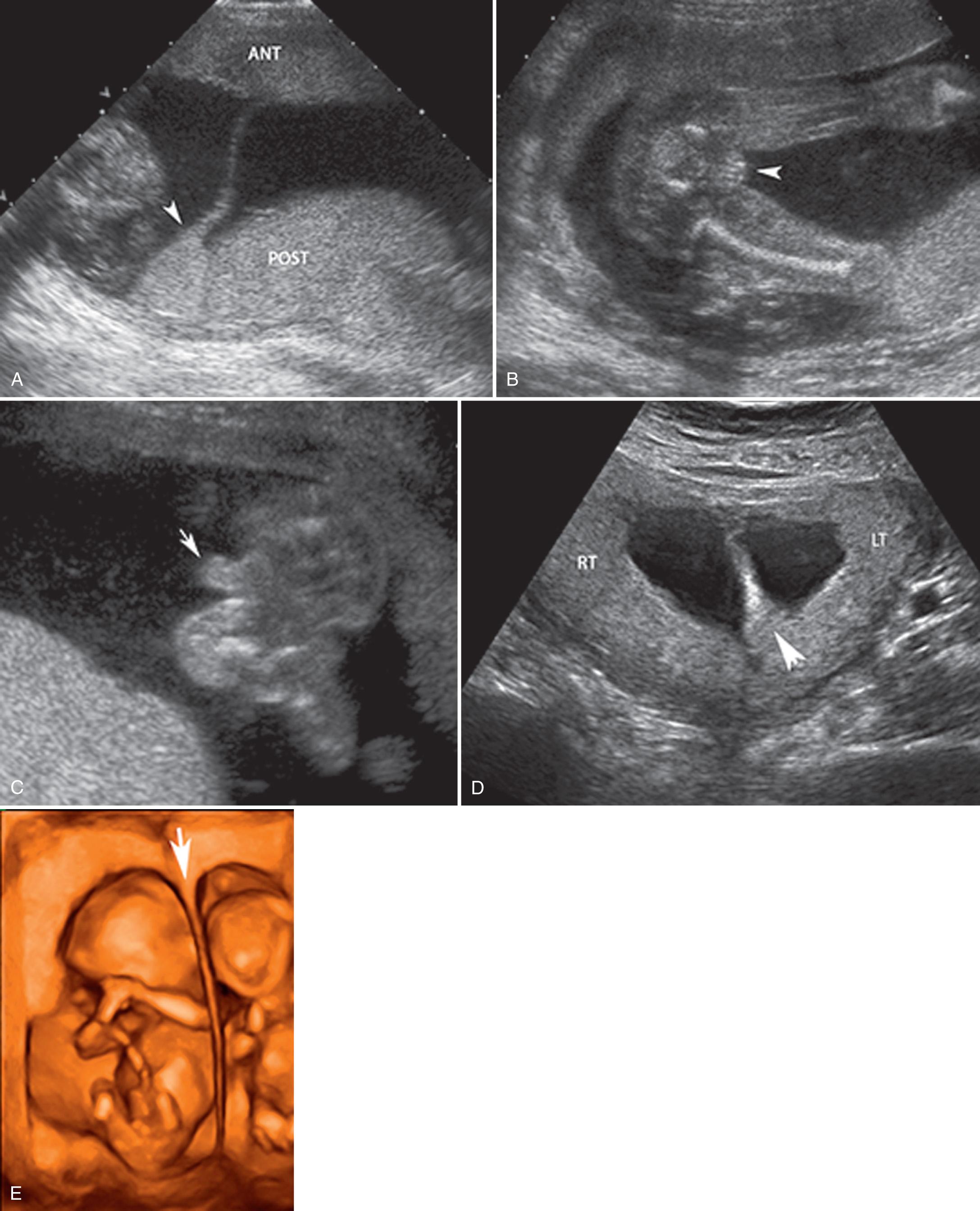
In a monochorionic gestation, the separating membrane is composed of two layers of amnion only, without chorion. The two-amnion membrane meets the placenta/single chorion in a T-shaped manner ( Fig. 32.5 ). Because of the presence of four layers (in dichorionic twins with the two thicker chorions and two thin amnions) versus two layers of membranes (in monochorionic twins with two thin amnions) between sacs, the membrane is subjectively thicker in dichorionic gestations than in monochorionic gestations, but this method is less reliable for chorionicity determination than the others described earlier. When the fetus is large enough to assess anatomy, fetal sex can assist in differentiating twin types. Two different sexes are obviously dichorionic, whereas same-sex twins can be either dichorionic or monochorionic. Monoamniotic twins can be accurately identified when there is entanglement of either fetal parts or the cord ( Fig. 32.6 , Video 32.3). For higher-order multiples, any combination of chorionicity and amnionicity is possible, and more than one means of determining the type of gestation may be needed ( Fig. 32.7 , Video 32.4).
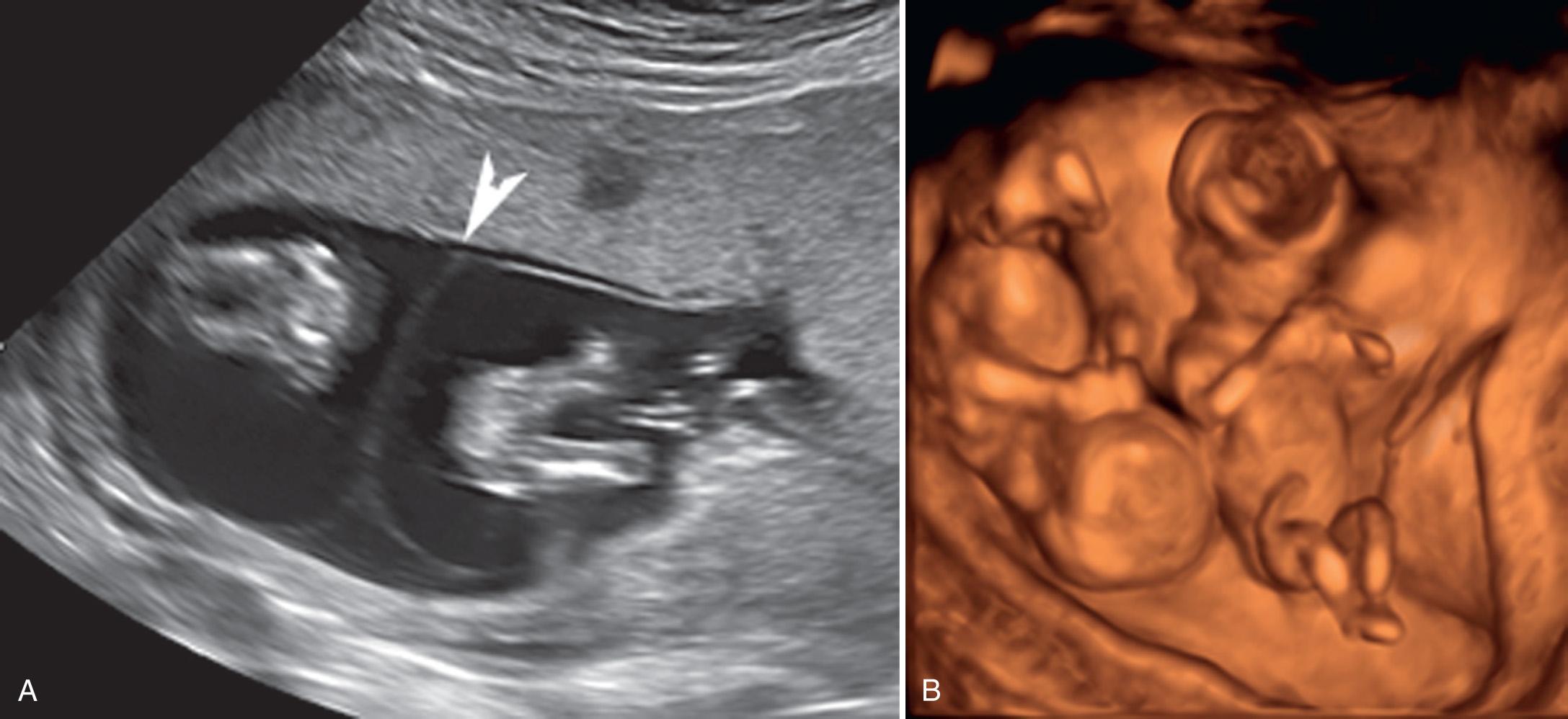
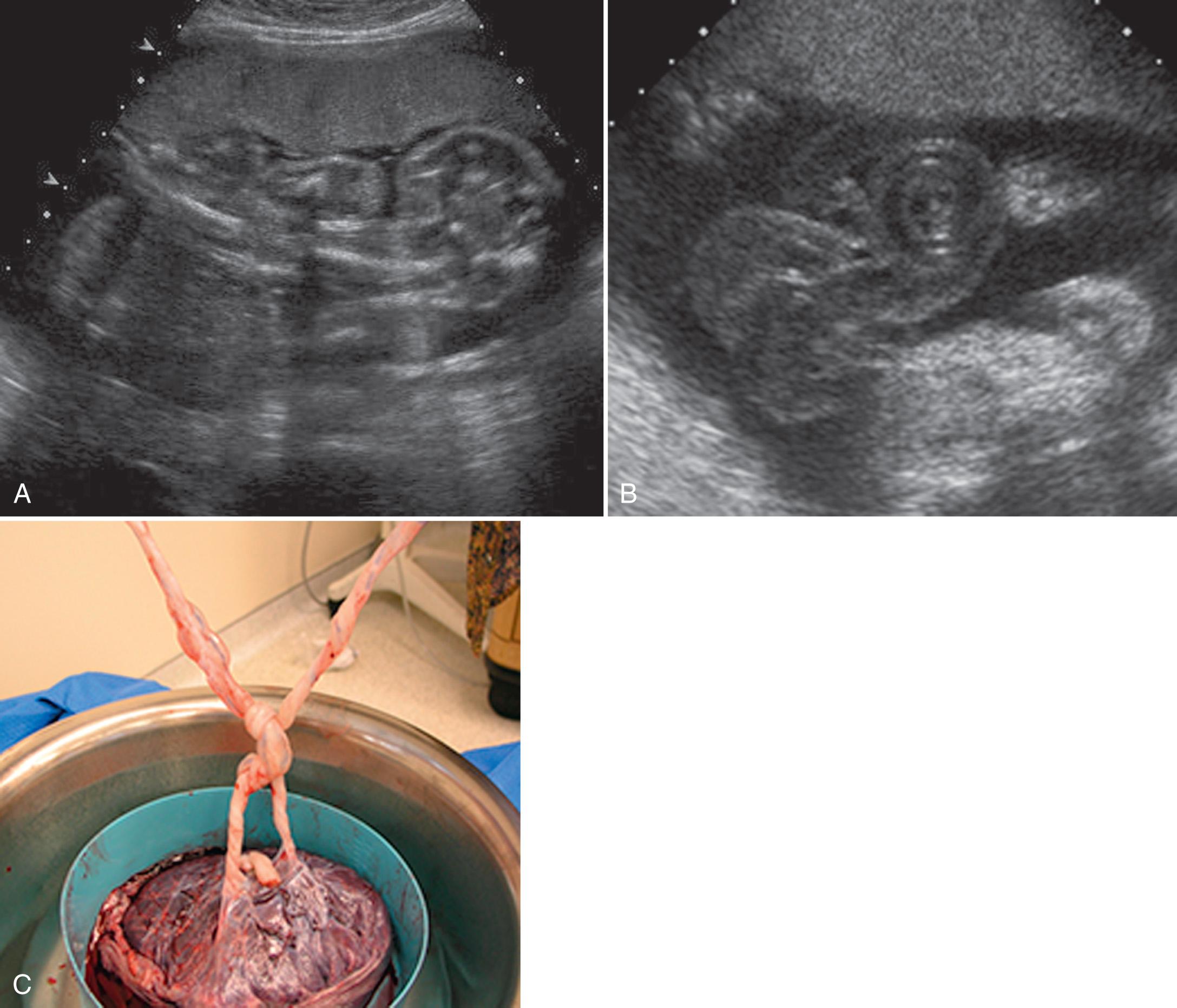
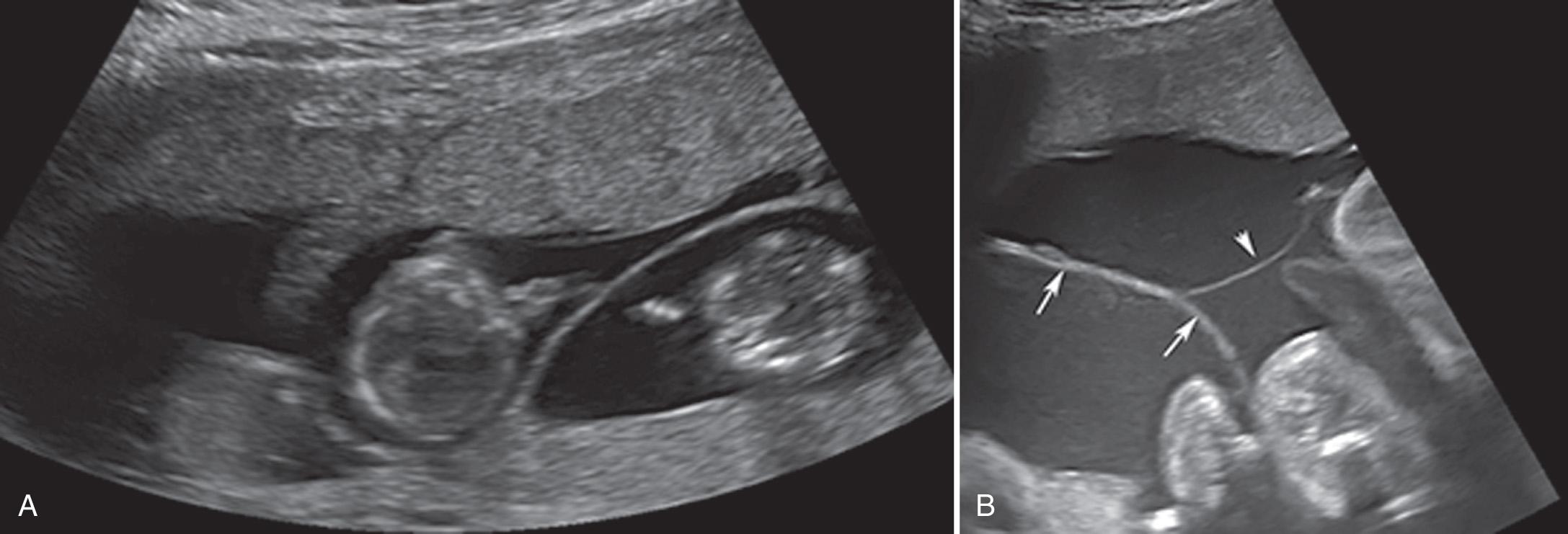
Become a Clinical Tree membership for Full access and enjoy Unlimited articles
If you are a member. Log in here